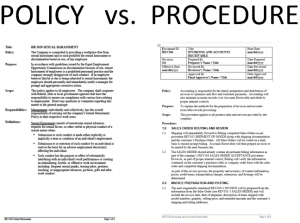How do you Structure a Policy and Procedure Manual?

If you are a manager or entrepreneur, you know the importance of having a clear and concise policy and procedure manual for your business. This manual outlines your company’s core values, compliance, communication, and how things should be done. In this article, you’ll find everything you need to know about creating an effective policy and procedure manual that will benefit your company. How do you structure a policy and procedure manual?
Understanding the Importance of a Policy and Procedure Manual

A policy and procedure manual is a critical component of any organization, no matter the size or type of business. It provides a clear set of guidelines and expectations for employees to follow, ensuring that everyone is on the same page and working towards the same goals. Creating a manual can help in several ways:
Ensuring Compliance with Laws and Regulations
A policy and procedure manual will help you ensure that your business adheres to all the applicable local, state, and federal laws and regulations. This is especially important in industries that are heavily regulated, such as healthcare or finance. By having a manual that outlines all the necessary legal requirements, you can avoid costly legal disputes and lawsuits.
For example, if your business deals with sensitive customer information, you may be required to comply with data protection laws such as GDPR or CCPA. Your policy and procedure manual can outline the steps that employees need to take to ensure that customer data is handled securely and in compliance with these regulations.
Establishing Consistent Practices
A policy and procedure manual sets a standard for how tasks should be performed within your organization. This ensures that all employees follow the same processes, increasing productivity and reducing errors. It also helps to ensure that tasks are completed in a timely and efficient manner.
For example, if your business has a customer service department, your policy and procedure manual could outline the steps that employees need to take when dealing with customer complaints. This could include specific language that should be used, as well as a timeline for responding to complaints and resolving issues.
Improving Employee Training and Onboarding
When new employees join your company, they can be quickly trained and brought up to speed on how things should be done. This reduces the risk of costly mistakes and makes it easier for new hires to become productive members of your team. A policy and procedure manual can be an invaluable tool for employee training and onboarding.
For example, if your business has a sales team, your policy and procedure manual could outline the steps that employees need to take when making a sale. This could include information on how to approach potential customers, how to handle objections, and how to close a sale.
Overall, a policy and procedure manual is essential for any organization that wants to operate efficiently and effectively. By providing clear guidelines and expectations for employees, you can ensure that everyone is working towards the same goals and that tasks are completed in a timely and efficient manner.
Identifying the Key Components of a Policy and Procedure Manual
Before you start Creating a Policies and Procedures Manual Template, it’s essential to understand the key components that should be included. These components will vary depending on the type of business, but the following are critical:
Company Overview and Mission Statement
When Organize Your Policies and Procedures Manual, the first section should describe your organization’s history, mission, vision, and values. These are the foundational principles that guide your business.
For example, if your organization is a non-profit that focuses on environmental conservation, your mission statement might be “to protect and preserve the natural environment for future generations through education, advocacy, and action.” Your company overview can also include information on your organization’s structure, such as its size, number of employees, and any key partnerships or collaborations.
Policies and Procedures
This section should include information on how to perform specific tasks and procedures on a day-to-day basis. It should outline the steps needed to be taken when a specific situation arises.
For example, if your organization is a healthcare provider, your policies and procedures section might include information on patient care, such as how to properly administer medication, how to handle medical emergencies, and how to ensure patient privacy. It’s important to ensure that all policies and procedures are clear, concise, and easily understood by all employees. This can help to prevent confusion, errors, and potential legal issues.
Roles and Responsibilities
This section should explain the different roles within your organization and the responsibilities associated with each role. It should also outline the management structure, including who reports to whom.
For example, if your organization is a marketing agency, your roles and responsibilities section might include information on the different departments within the agency, such as account management, creative services, and digital marketing. It might also outline the responsibilities of each department, such as managing client relationships, developing marketing strategies, and executing campaigns.
It’s important to ensure that all roles and responsibilities are clearly defined and understood by all employees. This can help to prevent confusion, duplication of efforts, and potential conflicts.
Communication and Reporting Processes
Clear communication is crucial to your business’s success. This section should outline how information is shared among employees and departments, as well as the reporting process for problems and incidents.
For example, if your organization is a manufacturing company, your communication and reporting processes section might include information on how to report equipment malfunctions, how to request materials, and how to communicate with other departments regarding production schedules.
It’s important to ensure that all communication and reporting processes are efficient, effective, and easily accessible to all employees. This can help to prevent delays, errors, and potential safety hazards.
Document Control and Revision Management
This section should detail how documents are created, approved, and updated. It should also explain how revisions are managed and communicated to employees.
For example, if your organization is a financial services provider, your document control and revision management section might include information on how to create and approve financial reports, how to ensure compliance with regulatory requirements, and how to manage changes to financial policies and procedures.
It’s important to ensure that all document control and revision management processes are well-documented, transparent, and easily accessible to all employees. This can help to prevent errors, inconsistencies, and potential legal issues.
Developing Clear and Concise Policies
Developing clear and concise policies is essential to creating an effective policy and procedure manual. This ensures that employees understand what is expected of them and reduces the risk of misunderstandings or non-compliance.
When developing policies, it’s important to consider the audience. Policies should be written in a way that is easily understood by all employees, regardless of their background or education level. This means avoiding technical jargon and using simple, clear language.
One way to ensure that policies are written in plain language is to have someone outside of the department or organization review them. This person can provide feedback on whether the policies are easy to understand and offer suggestions for improvement.
Writing in Plain Language
Policy and procedure manuals should be easy to understand. Avoid the use of technical terminology or jargon, and use simple and clear language that is easily understood by everyone.
In addition to using plain language, it’s important to organize policies in a logical and easy-to-follow manner. This can be achieved through the use of headings, subheadings, and bullet points.
When writing policies, it’s also important to consider the tone. Policies should be written in a professional, yet approachable tone, to help employees feel comfortable asking questions or seeking clarification.
Using Consistent Formatting and Structure
Consistency is key when creating a policy and procedure manual. Use the same formatting and structure for each section to ensure that the manual is easy to navigate and understand.
One way to achieve consistency is to use a template for all policies. This can help ensure that each policy follows the same structure and includes all necessary information.
It’s also important to consider the length of policies. While it’s important to include all necessary information, policies should be concise and to the point. If a policy is too long, employees may be less likely to read it in its entirety.
Incorporating Visual Aids and Examples
Visual aids and examples can help employees better understand what is expected of them. Incorporate charts, diagrams, and tables where appropriate to help communicate key points.
For example, if a policy outlines a process for requesting time off, a flowchart could be included to help employees understand the steps involved. Similarly, if a policy outlines expectations for dress code, photos could be included to provide visual examples.
Visual aids can also help break up large blocks of text, making policies easier to read and understand.
Ensuring Legal and Regulatory Compliance
Ensure that all policies and procedures outlined in the manual comply with all applicable laws and regulations. This can help you avoid costly legal disputes and lawsuits.
When developing policies, it’s important to consult with legal experts to ensure that they are in compliance with all relevant laws and regulations. This can include labor laws, health and safety regulations, and data privacy laws.
It’s also important to regularly review policies to ensure that they remain in compliance with any changes to laws or regulations.
Structuring a Policy and Procedure Manual
Creating an Effective Policy Procedure Manual is a critical component of running a successful business. It helps ensure compliance, establishes clear processes, and enables new employees to be quickly onboarded and productive. With the information provided in this article, you’ll be able to create a manual that is clear, concise, and effective.
















To ensure that they are in accordance with all applicable rules and regulations, it is crucial to contact with legal professionals.